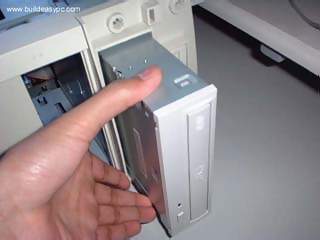|
"If you look at the rear side of your CD / DVD-ROM
it should look similar to image shown on figure 1."

Figure 1**
"On the right hand side you have the
power connector. Next to power connector you have the IDE connector. On
the left hand side near the IDE connector you have the jumper settings
for the DVD-ROM. The jumper is set to Master by default. I am connecting
the DVD-ROM on a separate IDE cable therefore I will leave the jumper
setting to Master. However if you are sharing an IDE cable with another
device like HDD, then you would have to set jumper to Slave, as your HDD
would be set to Master. Next to the jumpers you have the CD Audio-Out
socket. One side of your audio cable connects to this socket and other
side connects to the sound card cd-in socket. This would allow you to
listen to Audio CD's on your computer."*

Figure 2**
"Mount your CD/DVD-ROM drive into its
mounting slot. Use the supplied screws to screw the drive into position."*

Figure 3**
"Connect the IDE cable to the drives
IDE connector. Make sure the pin 1 on the cable is connected to pin 1
on the drives IDE connector. Pin 1 is the red or pink strip on the edge
of an IDE cable. Connect the other end of the IDE cable to the IDE socket
on your motherboard as shown in figure 4. Again, make sure you conncet
the cable to pin 1. The IDE socket could be your primary or secondary
socket depending which socket you choose. If your HDD is on the primary
IDE socket and your secondary IDE socket is free, then it is better to
use your secondary IDE socket for the CD/DVD-ROM."*

Figure 4**
"Finally connect the power cable to
power connector and connect the audio cable to the CD Audio-Out socket
as shown on figure 3."*
|
